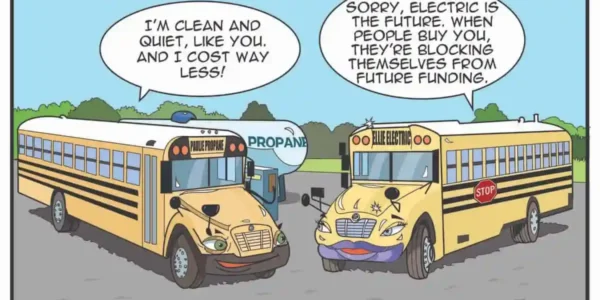Why to choose Electric over Propane School Buses?

I’ll be transparent about my agenda: I want the EPA’s Clean School Bus Program to be flooded by applications this summer for electric school buses ( ESB’s). It’s true that propane buses run cleaner and quieter than diesel, and cost way less than electric. But electric is solidly better for our kids, communities and climate than propane or any other fuel.
Read on for five reasons they are better and a fun cartoon of Ellie Electric and Paulie Propane.
1.) ESB’s ensure fuel price stability. Propane prices are volatile, as are gas and diesel, because they are all petroleum-based, and vulnerable to global markets. All those fuels have risen in price since the war in Ukraine started, for example. Electricity, in contrast, is produced here in the U.S., sometimes very locally, and changes little in price. Stable fuel prices are good for bus fleets.

3.) Propane buses block future funding. ESB’s attract it. Every school bus purchased lasts 15-20 years, so we’ve got to think long-term, not short-term. Both the private sector and the public sector are investing billions of dollars in electric vehicle charging infrastructure, because electricity is the cleanest, most efficient fuel, and electric is the future. We’re not seeing billions invested in propane infrastructure. Most propane buses, ironically, aren’t dirty enough to qualify to be replaced with current funding sources. Fossil fuels (propane is a fossil fuel) are being phased out, in the same way that old-fashioned, hot-burning light bulbs have been replaced by cool-burning, energy-efficient LED’s. Propane school buses at this point are like compact fluorescent light bulbs (CFL’s) – they were a big step forward when first invented, but are now of the past.

![]()
4.) ESB’s train the work-force with durable skills for the clean energy economy described above. ESB’s also protect mechanics and drivers from tailpipe emissions (they have no tailpipes). School districts, like everyone these days, struggle to recruit and retain good employees. Propane buses keep workers stuck in old skills based on the internal combustion engines that are being phased out. The state of New York, for example, has decided to replace all its diesel school buses, including in its rural districts, with electric by 2035.
To be fair, when I interviewed Allen Walz, the Transportation Director of Brookings-Harbor School District in Oregon, I gained insight into propane’s popularity. He has a 22 bus fleet in a rural area, seven propane, the rest diesel. “I’m saving $4,000 per bus per year with propane over diesel, between cheaper fuel and way less maintenance. Plus you can stick your nose up the tailpipe [of propane] and not die. . . . But I like electric, I like the whole philosophy of it. Sure, you can help me apply for funding for my first electric school bus . . . Is my school board supportive? Well, they need to see electric not cost any more than my current buses.” Keep reading.
5.) ESB fleets will eventually support electrical grid resilience. Propane will not. Power outages due to extreme weather events (especially wildfires here in the West) are increasingly common. While propane fuel is useful to communities when grids go down, it has no power (ha!) to run electricity into a building or to support the electric grid, itself. Vehicle to grid (V2G) and, more locally, vehicle to building (v2B) transfer of energy is unique to electric buses. V2G and V2B create resilience as our climate goes haywire, and V2G can also eventually generate revenue for school districts. That last is part of why Highland is financing entire fleet transitions from diesel to electric, keeping school bus fleets’ current costs the same as buses age out and get replaced.
Finally, I’m impressed by this new report on ESB’s by Erik Curren of Secure Futures, which is experienced at installing solar arrays at schools and is now facilitating ESB’s as well (these are a great combination when you can get the funding).
